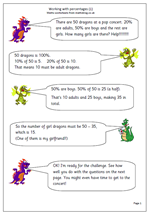This week’s resource of the Week highlights the second of our percentages worksheets for Year 5. It is typical of the English that we manage to write per cent in two different ways. Unlike the Americans who use percent we use two words per cent, apart from when we write percentage when we put it altogether. 
Anyway, as to the maths: remember that many percentages can be worked out ‘in your head’ by remembering that 10% of an amount is equivalent to dividing the amount by 10. At this stage we will only be dealing with whole tens so it is probably the best approach. Later more complicated percentages will be found by dividing by 100 and multiplying by the percentage.
To find 20% of £350.
Find 10% of £350, which is £35
If 10% is £35, then 20% will be £35 x 2 = £70.


